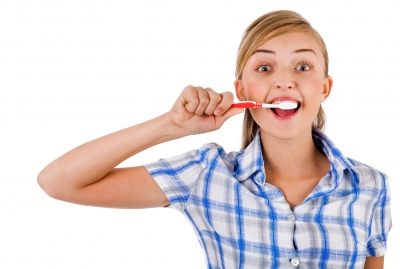
How To Brush Your Teeth: A Refresher Course. No pun intended. (Get it? Refresher? Fresh breath? Ok, some of my jokes are pretty lame, I know)
Let’s go back to basics here. I’m sure you’ve been brushing your teeth for a long time, and you know what you’re doing. Or maybe you just think you know. But I’m willing to bet that a majority of people don’t brush their teeth in the most effective way. Why? Because if we all brushed properly, we’d probably see far fewer cavities in our office. Just imagine: You’d be able to walk the streets and not smell someone else’s halitosis. Food stuck in teeth would be a very rare sight. Everyone would have all of their teeth. Or at least, most of them.
So, let’s discuss the Do’s and Don’t’s of tooth brushing, shall we?
1. Do use a clean toothbrush. Toothbrushes are filled with germs and the bristles wear out. You’ll leave our office every 6 months with a brand new brush, but try to replace that one in between your visits as well. The ADA recommends that you replace your toothbrush every 3 months. If you get sick, that’s another great time to replace it.
2. Don’t skimp on brushing time. Dentists recommend that you brush for 2 minutes. Set a timer, play a short song, or if you have a fancy electronic toothbrush, they usually have a built-in timer. We sell a great one, Sonicare, here in the office that times your brushing. Personally, I spend 30 seconds in each “quadrant” of my mouth and then move on. Then I do a little dance when I’m done. Hey, it’s the little things, right?
3. Don’t brush too hard. Our office dispenses soft bristled toothbrushes. That’s what you should be using, always. We aren’t even sure why the drugstore sells “hard” bristled toothbrushes. Maybe to clean toilets? In fact, one of our employee’s former dentist used to say “the only thing hard bristled toothbrushes are good for is cleaning your kitchen floor.” Hard brushing isn’t good for teeth or gums, period. It can cause recession and it can wear down the enamel on your teeth. For some reason I am remembering a commercial from the 90s where someone brushes a tomato with a toothbrush. You should be brushing gently enough so that you don’t break the skin on the tomato. Give it a try. If you’re brushing for 2 minutes like recommended, you shouldn’t need to brush “hard” anyway.
4. Do brush in a circular motion. Teeth have a lot of different crevices, and brushing strictly back and forth doesn’t do them justice. Hold your toothbrush at a 45 degree angle and brush in small circles. This helps the bristles get slightly below the gum line and removes bacteria and food particles.
5. Don’t skip the insides. The inside of your teeth need a lot of attention too, so make sure you give it to them. If you spend 30 seconds per quadrant like I do, then you should spend 15 on the outside and 15 on the inside. It might start to feel redundant but I promise, as soon as you rinse your mouth out your teeth will feel cleaner than they have in months.
6. Do brush your tongue. Tongues usually have a lot of plaque on them, and plaque causes bad breath. Brushing or scraping your tongue with a tongue scraper does a world of wonders for your overall oral health – and smell.
7. Don’t brush too often, but Do brush at least twice a day! Most people brush too infrequently – one time a day or less (can you believe that? Gross!) but some people go overboard and brush after every time they eat. There is a balance here. Dentists recommend brushing at least twice a day, no more than three times. Too little brushing doesn’t adequately clean teeth while too much brushing can wear down enamel and cause gum recession.
8. DO FLOSS! Dentists aren’t trying to nag you or drive you crazy when they tell you to floss. It’s true! Flossing is essential for overall oral health. In fact, if everyone did this one little thing every day, I venture to guess that dentists would be out of a job. If you haven’t flossed in a while or don’t floss often and see red when you do, don’t panic. Bleeding gums are a sign of inflammation and they will get better over time – as long as you continue to floss. The inflammation is NOT from flossing, the inflammation is from bacteria left behind from NOT flossing. So just do it, ok?
If you follow these recommendations, your teeth will be sparkling in no time. Your breath will be fresh and your friends will thank you.
If you need any more tooth brushing advice or want an in-person refresher course, call our Brookfield Wisconsin office today at 262-784-7201 to set up an appointment.
